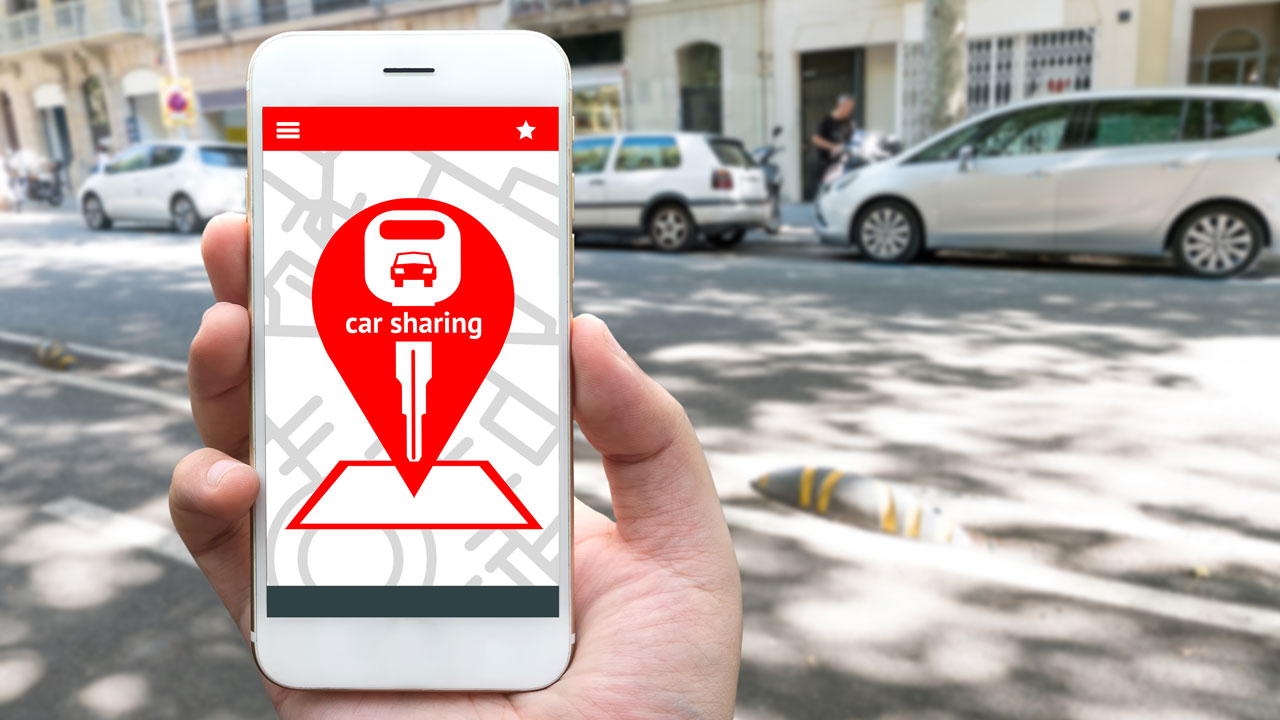CO2 einsparen mit carsharing
Wenn wir die Auswirkungen der Klimakrise begrenzen wollen, müssen wir CO2 einsparen. Viel Potential hat der Verkehrssektor, der mit rund 18 Prozent in hohem Maße zum Ausstoß beiträgt. Innerhalb dieses Sektors wiederum schlägt vor allem der Autoverkehr zu Buche. Eine Möglichkeit, diese Emissionen deutlich zu reduzieren, sind Carsharing-Angebote.

Welche Arten von Carsharing gibt es?
Man unterscheidet zwischen stationärem Carsharing und flexiblem, bzw. sogenanntem Free-Floating.
Stationäres Carsharing bedeutet: Der Anbieter parkt seine Fahrzeuge an festen Standorten. Nutzer:innen können die Autos online reservieren, abholen und müssen sie an den gleichen Parkplatz zurückbringen. Das System hat viele Vorteile: Der Anbieter hat meist viele verschiedene Fahrzeuge im Angebot, so dass die Auswahl nach dem aktuellen Bedürfnis erfolgen kann: Muss ich etwas transportieren? Nutze ich das Auto alleine oder mit Mitfahrenden? Dank der Reservierung kann ich mich darauf verlassen, das Fahrzeug zum Termin an vordefinierter Stelle vorzufinden, und die Nutzungsgebühr pro Stunde ist gering.
Beim sogenanntem Free Floating können Nutzer:innen dagegen spontan sein: Innerhalb eines festgelegten Gebietes steht das Autos dort, wo die letzte Person es abgestellt hat. Über eine App können Interessierte prüfen, ob aktuell ein Fahrzeug in der Nähe verfügbar ist. Da das Auto nicht an den ursprünglichen Parkplatz zurückgebracht werden muss, bietet es sich vor allem für Fahrten in einfache Richtung an. Die Gebühr pro Stunde ist hier allerdings höher als beim stationären Modell.
- Ein privater PKW wird durchschnittlich nur 1 Stunde am Tag bewegt, d.h. für 23 Stunden/Tag nimmt er ungenutzt Raum ein.
- Zwischen 2011 und 2020 hat sich die Zahl der Carsharing-Nutzer:innen verelffacht. Heute nutzen über 2,2 Millionen Menschen diese Möglichkeit
- Viele Städte setzen auf Carsharing als wichtigen Mobilitätsbaustein. So bietet Augsburg eine „Mobil-Flat“ an: Ein Fixpreis deckt die Nutzung von Bus, Bahn, Carsharing-Auto und Leihfahrrad an.
In einigen Städten werden inzwischen Mischformen angeboten. In jedem Modell haben Nutzer:innen einige Vorteile:
Rund die Hälfte bis 2/3 der Kosten, die ein eigenes Auto verursacht, fallen für Versicherung, Wartung und Service an. Das ist den wenigsten klar: Laut einer Studie aus dem Jahr 2020 schätzen Autobesitzer:innen alle anfallenden Kosten um durchschnittlich 50% zu gering ein.
Dazu gehört vor allem eine große Kostenersparnis. Die meisten PKW-Besitzer:innen unterschätzen die Kosten ihres eigenen Fahrzeugs und kalkulieren in erster Linie mit den Benzinpreisen. Dazu addieren sich jedoch die Kosten für Versicherung, TÜV, Wartung und Reparaturen, die ja oft sehr teuer sind. Auch der Wertverlust sollte einkalkuliert werden.
Die Nutzung eines Carsharingangebots ist – bis etwa 10.000 bis 12.000 km Fahrleistung pro Jahr – günstiger als ein eigenes Fahrzeug und dazu absolut transparent: Neben der monatlichen Grundgebühr fallen lediglich feste Kosten pro Fahrt an. Alle weiteren Punkte – einschließlich Sprit – werden vom Anbieter übernommen.
Welche Vorteile hat Carsharing für die Umwelt?
Carsharing-Autos sind in der Regel Neuanschaffungen und daher deutlich energieeffizienter als der durchschnittliche deutsche PKW. Sie stoßen, pro gefahrenem Kilometer, weniger CO2 aus. Darüber hinaus ist der Anteil an E-Autos unter den Carsharing-Angeboten signifikant höher als unter den Privat-PKWs, was erneut den CO2-Ausstoß senkt.
Eine Studie des Umweltbundesamtes hatte schon 2015 berechnet, dass das Einsparpotential der Carsharing-Angebote mehr als sechs Millionen Tonnen CO2 pro Jahr liegt, also etwa 4% der verkehrsbedingten CO2-Emissionen.
“Carsharing-Fahrzeuge emittieren pro gefahrenen Kilometer 16 % weniger klimaschädliches Kohlendioxid als durchschnittliche private Neufahrzeuge in Deutschland.”
Umweltbundesamt
Carsharing verändert das Nutzungsverhalten
Der wichtigste Aspekt ist jedoch: Carsharing verändert das Nutzungsverhalten. Der Bundesverband CarSharing hat 2016 in einer Studie untersucht, welchen Einfluss die entsprechenden Angebote auf Nutzer:innen und Städte haben:
40% der Befragten gaben an, seltener Auto zu fahren und häufiger andere Möglichkeiten wie Bus, Bahn oder Fahrrad zu nutzen. 18% der Autos, die bei der Anmeldung zu einem Carsharing-Anbieter vorhanden waren, wurden im Laufe der Nutzung abgeschafft – also immerhin fast jeder fünfte Privat-PKW.

Dazu kommt, dass in den 12 Monaten vor der Anmeldung gut die Hälfte der bis dahin verfügbaren Autos abgeschafft wurde. Carsharing wird also dann gerne getestet, wenn das eigene Fahrzeug kaputt geht oder etwa durch eine Trennung nicht mehr verfügbar ist – und erweist sich dann als gute Alternative.
Das hat große Auswirkungen auf Städte: Ein Carsharing-Auto kann bis zu 20 private PKWs ersetzen. Das spart Platz auf der Straße und reduziert die Anzahl der benötigten Parkplätze in Wohngebieten genauso wie in Innenstädten. So kann Raum geschaffen werden, um beispielsweise Grünflächen zu schaffen oder Bäume anzupflanzen – eine Maßnahme, die nicht nur die Lebensqualität der Anwohner:innen steigert, sondern auch Hitzewellen abmindert, die der Klimawandel deutlich wahrscheinlicher macht.
Grenzen des Carsharing
Carsharing ist und bleibt vor allem in Städten ein attraktives Angebot, das den ohnehin gut ausgebauten öffentlichen Nahverkehr flexibel ergänzt. Schwierig bleibt es bislang im ländlichen Raum. In nur rund 4% der Kommunen mit weniger als 20.000 Einwohner:innen können Menschen ein Carsharing-Angebot wahrnehmen.
Dabei kann es sich auch hier wirtschaftlich lohnen: Etwa durch Kooperationen mit den Kommunen selbst sowie mit Firmen und Mitarbeitertarifen. Wirklich attraktiv wird Carsharing für die Nutzer:innen im ländlichen Raum jedoch nur, wenn es so gut ausgebaut und einfach zu bedienen ist, dass ein Auto (das einzige oder zumindest der Zweitwagen) dadurch überflüssig wird.
Gerade in Städten hat Carsharing großes Potential: Es ist attraktiv für Nutzer:innen, weil es Flexibilität ermöglicht, kostentransparent ist und in vielen Fällen günstiger abschneidet als ein eigener PKW. Die Angebote tragen daher in großem Maße zum Klimaschutz bei: Carsharing-Autos sind in der Regel moderner, verursachen weniger CO2 und fahren häufig elektrisch. Sie lassen Nutzer:innen hinterfragen: Benötige ich nun tatsächlich ein Auto oder kann ich die Strecke mit Fahrrad, Bus oder Bahn zurücklegen?
